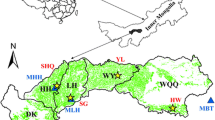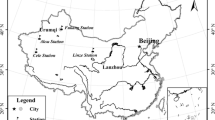Abstract
Irrigation is the major user of allocated global freshwaters, and scarcity of freshwater threatens to limit global food supply and ecosystem function—hence the need for decision tools to optimize use of irrigation water. This research shows that variable alluvial soil ideally requires variable placement of water to make the best use of irrigation water during crop growth. Further savings can be made by withholding irrigation during certain growth stages. The spatial variation of soil water supplied to (1) pasture and (2) a maize crop was modelled and mapped by relating high resolution apparent electrical conductivity maps to soil available water holding capacity (AWC) at two contrasting field sites. One field site, a 156-ha pastoral farm, has soil with wide ranging AWCs (116–230 mm m−1); the second field site, a 53-ha maize field, has soil with similar AWCs (161–164 mm m−1). The derived AWC maps were adjusted on a daily basis using a soil water balance prediction model. In addition, real-time hourly logging of soil moisture in the maize field showed a zone where poorly drained soil remained wetter than predicted. Variable-rate irrigation (VRI) scenarios are presented and compared with uniform-rate irrigation scenarios for 3 years of climate data at these two sites. The results show that implementation of VRI would enable significant potential mean annual water saving (21.8% at Site 1; 26.3% at Site 2). Daily soil water status mapping could be used to control a variable rate irrigator.






Similar content being viewed by others
References
Allen, R. G., Pereira, L. S., Raes, D., & Smith, M. (1998). Crop evapotranspiration. Guidelines for computing crop water requirements. FAO irrigation and drainage paper 56. Rome: FAO.
Blonquist, J. M., Jones, S. B., & Robinson, D. A. (2006). Precise irrigation scheduling for turfgrass using a subsurface electromagnetic soil moisture sensor. Agricultural Water Management, 84, 153–165.
Bradbury, S. (2009). Variable-rate irrigation for centre pivot and linear move irrigators. http://www.precisionirrigation.co.nz/index.php. Accessed 10 March 2009.
Brevik, E. C., Fenton, T. E., & Lazari, A. (2006). Soil electrical conductivity as a function of soil water content and implications for soil mapping. Precision Agriculture, 7, 393–404.
Burt, C. M. (2006). Volumetric water pricing. ITRC report no. R 06–002. San Luis Obispo: California Polytechnic State University.
DeJonge, K. C., Kaleita, A. L., & Thorp, K. R. (2007). Simulating the effects of spatially variable irrigation on corn yields, costs, and revenue in Iowa. Agricultural Water Management, 92, 99–109.
Dukes, M. D., & Perry, C. (2006). Uniformity testing of variable-rate center pivot irrigation control systems. Precision Agriculture, 7, 205–218.
Green, S. R., Kirkham, M. B., & Clothier, B. E. (2006). Root uptake and transpiration: From measurements and models to sustainable irrigation. Agricultural Water Management, 86, 165–176.
Hanks, R. J. (1974). Model for predicting plant yield as influenced by water use. Agronomy Journal, 66, 660–664.
Hedley, C. B., Yule, I. Y., Eastwood, C. R., Shepherd, T. G., & Arnold, G. (2004). Rapid identification of soil textural and management zones using electromagnetic induction sensing of soils. Australian Journal of Soil Research, 42, 389–400.
Hedley, C. B., Yule, I. J., Tuohy, M. P., & Kusumo, B. H. (2008a). Development of proximal sensing methods for mapping soil water status in an irrigated maize field. In: Australian Centre for Precision Agriculture (Eds.), Proceedings of the 1st global workshop on high resolution digital soil sensing and mapping, held under the auspices of the International Union of Soil Sciences (IUSS), Working group on digital soil mapping, 5–8 February 2008, Sydney, Australia, CD-Rom.
Hedley, C. B., Yule, I., & Bradbury, S. (2008b). Spatial irrigation scheduling with soil EM mapping. In Irrigation New Zealand (Ed.), Handbook of 1st Irrigation New Zealand conference, 14–15 October, 2008, Abstract CS5:02 (pp. 56). Christchurch: Caxton Press.
Hewitt, A. E. (1998). New Zealand soil classification (2nd ed., p. 133). Canterbury: Manaaki Whenua Press.
Hoekstra, A. Y., & Chapagain, A. K. (2008). Globalization of water: Sharing the planet’s freshwater resources. USA: Blackwell Publishing Ltd.
Jury, W. A., & Vaux, H. J. (2007). The emerging global water crisis: Managing scarcity and conflict between water users. Advances in Agronomy, 95, 1–76.
Kang, S., Shi, W., & Zhang, J. (2000). An improved water-use efficiency for maize grown under regulated deficit irrigation. Field Crops Research, 67, 207–214.
King, B. A., & Kincaid, D. C. (2004). A variable flow rate sprinkler for site-specific irrigation management. Applied Engineering in Agriculture, 20, 765–770.
Lu, Y.-C., Sadler, E. J., & Camp, C. R. (2005). Economic feasibility study of variable irrigation of corn production in southeast coastal plain. Journal of Sustainable Agriculture, 26, 69–81.
Morgan, M., Bidwell, V., Bright, J., McIndoe, I., & Robb, C. (2002). Canterbury strategic water study. Prepared for MAF, ECan and MfE. Report no 4557/1, August 2002. Lincoln, Canterbury: Lincoln Environmental.
New Zealand Ministry for the Environment. (2007). Environment New Zealand 2007. Published by the Ministry for the Environment, Wellington, New Zealand, Dec 2007. http://www.mfe.govt.nz/. Accessed 10 March 2009.
Russo, D. (1986). A stochastic approach to the crop yield-irrigation relationships in heterogeneous soils: I. Analysis of the field spatial variability. Soil Science Society of America Journal, 50, 736–745.
Sadler, E. J., Camp, C. R., Evans, D. E., & Millen, J. A. (2002). Spatial variation of corn response to irrigation. Transactions of the ASAE, 45, 1869–1881.
Sadler, E. J., Evans, R. G., Stone, K. C., & Camp, C. R. (2005). Opportunities for conservation with precision irrigation. Journal of Soil and Water Conservation, 60, 371–379.
Sudduth, K. A., Kitchen, N. R., Wiebold, W. J., Batchelor, W. D., Bollero, G. A., Bullock, D. G., et al. (2005). Relating apparent electrical conductivity to soil properties across the north-central USA. Computers and Electronics in Agriculture, 46, 263–283.
Swaminathan, M. S. (2007). Can science and technology feed the world in 2025? Field Crops Research, 104, 3–9.
UN/WWAP (United Nations/World Water Assessment Programme). (2003). First UN world water development report: Water for people, water for life. Paris: UNESCO and Bergham Books.
Waine, T.W., Blackmore, B.S., & Godwin, R.J. (2000). Mapping available water content and estimating soil textural class using electro-magnetic induction. EurAgEng Paper 00-SW-044. Warwick, UK: AgEng 2000.
Young, M., & Hatton, D. H. (2000). Inter-state water trading: A 2-year review. Natural resource management economics 00_001, policy and economic research unit. Adelaide: CSIRO Land and Water.
Acknowledgments
The authors are grateful for assistance from Stuart Bradbury and Mike Tuohy with EM mapping, John Dando with soil analysis and Dave Scotter with soil water balance modelling. Funding support for this research was provided by the New Zealand Agricultural and Marketing Research and Development Trust (AGMARDT) and a NZVCC William Georgetti scholarship.
Author information
Authors and Affiliations
Corresponding author
Rights and permissions
About this article
Cite this article
Hedley, C.B., Yule, I.J. Soil water status mapping and two variable-rate irrigation scenarios. Precision Agric 10, 342–355 (2009). https://doi.org/10.1007/s11119-009-9119-z
Received:
Accepted:
Published:
Issue Date:
DOI: https://doi.org/10.1007/s11119-009-9119-z




